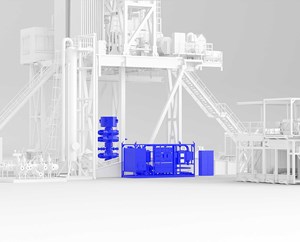(WO) – Day one of OTC 2025 kicked off Monday, May 5, in Houston, Texas. Offshore innovations and industry priorities in the current economic and geopolitical climate led much of the discussion on day one, exemplified in a panel titled, “Driving Efficiency and Innovation in Offshore Production Through Electrification.” During the conversation, a central theme emerged for the conference at large: the balancing act of reducing emissions while increasing production to meet the ever-growing energy demand, leveraging the unique benefits of electrification technology.

SLB’s electric well control technology
ADNOC’s VP of Upper Zakum Khaled Al Kindi opened the panel with a swift rundown of ADNOC’s $3.8 B electrification megaproject. Set to be completed in 2026, the megaproject will contribute to the major’s existing 2045 net zero goals by transitioning subsea gas generators for a nuclear and solar grid supply mix. Yet ADNOC is far from the only one looking to leverage electrification technologies to reduce emissions. Corporate Head of Well Completions Muhammad Sofyan, TotalEnergies, presented all-electric wells—compared with previous models of hydraulic of hybrid hydraulic-electric wells—as a means of not only reducing emissions but also reducing overall costs for companies.
Opportunities to reduce costs in various offshore operations is more critical than ever, with current market volatility for a variety of reasons. This theme underlaid many of the individual discussions within the panel, including input from Principal Production Champion Alan Mclauchlan, Halliburton, Integrated Solutions Domain Manager Stephan Dyer, SLB, Technology and Assurance President Jeremy Hall, Wood and Principal Systems Architect for Marketing and Technology Burkhard Sommer, SLB. All three presented similar benefits for electrification opportunities, from all-electric completions to general subsea electrification, externally powered FPSOs and subsurface electrification: electrification adds speed to installation, maintenance and operations, allowing for cost and time savings in addition to reduced emissions.
Some of these reductions can be substantial; according to Mclauchlan, all-electric well completions, for example, boast nearly a quarter of the installation costs associated with their traditional hydraulic counterparts. A similar reduction in CO2 emissions can also be achieved, per Mclauchlan, almost entirely thanks to the new speed and flexibility that electric solutions can offer.
Considering the benefits for offshore operations’ speed, costs and emissions, there was little surprise that the Q&A session following the panel presented the obvious question: why isn’t the offshore industry adopting electric solutions at a higher rate? The answer was manifold, according to input from various panelists. Dyer noted that the next couple of years should see an increase of around a hundred installations, as various operations reach the ramp-up phase of application following earlier investment. Even so, for many applications, the decision involves a question of up-front versus long-term costs. Per Sommer, all-electric systems are significantly cheaper on the whole, but they require substantial up-front investment. Even then, he said, hybrid electric-hydraulic systems sometimes present the most economical choice in scenarios where a full electric transition is limited. Hall added that there are also mindset considerations—a point echoed by Sofyan. Both panelists noted that the industry’s reluctance and inertia will be difficult to overcome, especially when new electric systems present the need for new training, skills and operations routines. Even then, there are other concerns to contend with, such as lacking supply chains, as mentioned by Hall. Still, as Dyer was quick to point out, “electric is already here,” and the technology does not look to slow down anytime soon.

